Leadership Strategies for Business Organizations: A Starbucks Report
VerifiedAdded on 2023/01/18
|15
|4453
|45
Report
AI Summary
This report delves into the realm of leadership within business organizations, using Starbucks as a central case study. It commences with an examination of fundamental leadership questions, key aspects of leadership, and the importance of understanding various leadership theories and styles, particularly those suited to volatile, ambiguous, complex, and uncertain (VUCA) business environments. The report then explores the significance of organizational vision, mission, and the contributions of individuals, leaders, and stakeholders in executing them. Leadership strategies, including change leadership, organizational potential, and the impact of the business context, are also analyzed. Furthermore, it discusses motivation theories, including content and process theories, contemporary motivational terms, and the appreciative inquiry technique, emphasizing their relevance in an organizational context. The report then transitions to a discussion of servant leadership, its challenges in VUCA environments, and an evaluation of a specific leader's style. The report concludes with recommendations for maintaining competitive advantage and sustainability within Starbucks.
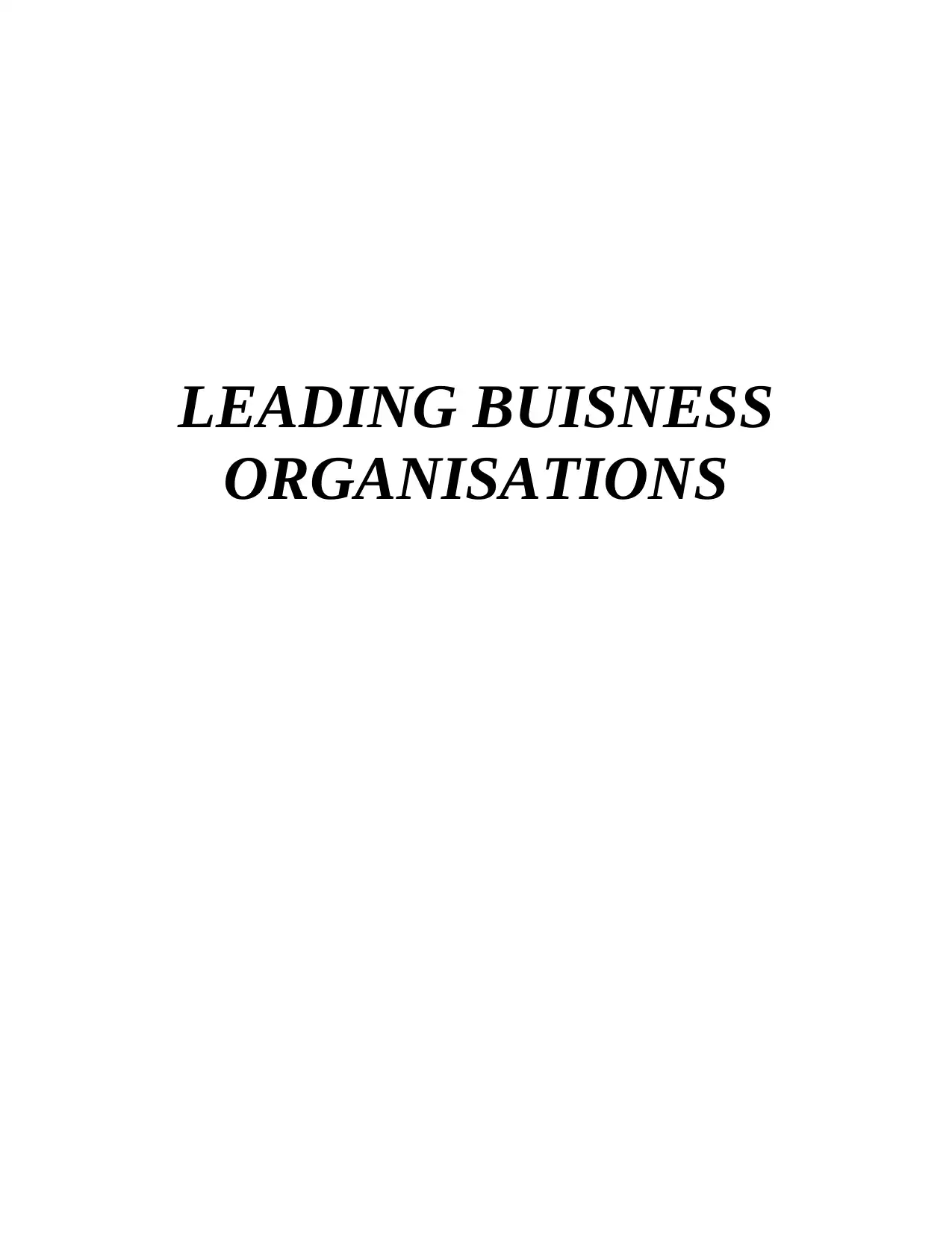
LEADING BUISNESS
ORGANISATIONS
ORGANISATIONS
Paraphrase This Document
Need a fresh take? Get an instant paraphrase of this document with our AI Paraphraser
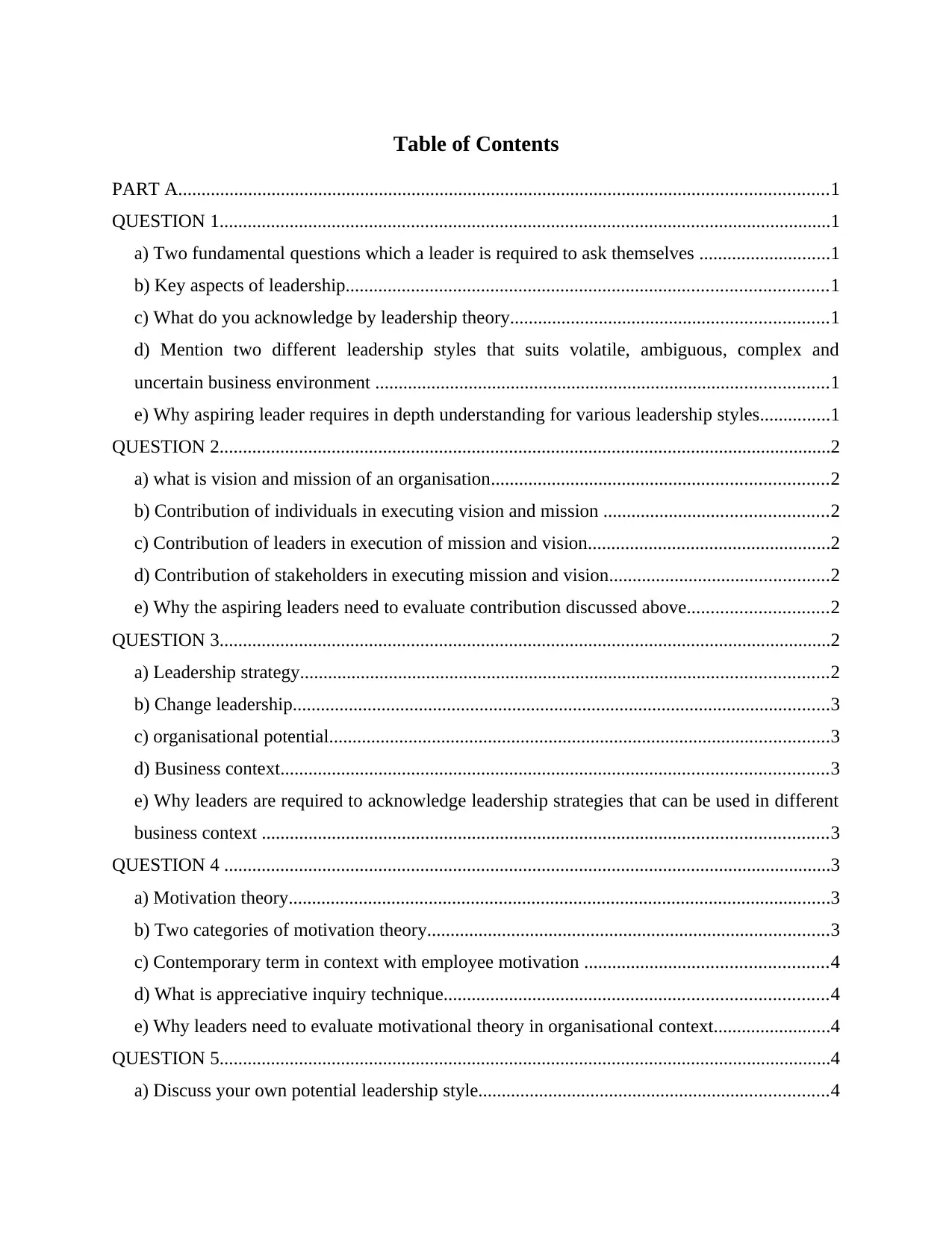
Table of Contents
PART A...........................................................................................................................................1
QUESTION 1...................................................................................................................................1
a) Two fundamental questions which a leader is required to ask themselves ............................1
b) Key aspects of leadership.......................................................................................................1
c) What do you acknowledge by leadership theory....................................................................1
d) Mention two different leadership styles that suits volatile, ambiguous, complex and
uncertain business environment .................................................................................................1
e) Why aspiring leader requires in depth understanding for various leadership styles...............1
QUESTION 2...................................................................................................................................2
a) what is vision and mission of an organisation........................................................................2
b) Contribution of individuals in executing vision and mission ................................................2
c) Contribution of leaders in execution of mission and vision....................................................2
d) Contribution of stakeholders in executing mission and vision...............................................2
e) Why the aspiring leaders need to evaluate contribution discussed above..............................2
QUESTION 3...................................................................................................................................2
a) Leadership strategy.................................................................................................................2
b) Change leadership...................................................................................................................3
c) organisational potential...........................................................................................................3
d) Business context.....................................................................................................................3
e) Why leaders are required to acknowledge leadership strategies that can be used in different
business context .........................................................................................................................3
QUESTION 4 ..................................................................................................................................3
a) Motivation theory....................................................................................................................3
b) Two categories of motivation theory......................................................................................3
c) Contemporary term in context with employee motivation ....................................................4
d) What is appreciative inquiry technique..................................................................................4
e) Why leaders need to evaluate motivational theory in organisational context.........................4
QUESTION 5...................................................................................................................................4
a) Discuss your own potential leadership style...........................................................................4
PART A...........................................................................................................................................1
QUESTION 1...................................................................................................................................1
a) Two fundamental questions which a leader is required to ask themselves ............................1
b) Key aspects of leadership.......................................................................................................1
c) What do you acknowledge by leadership theory....................................................................1
d) Mention two different leadership styles that suits volatile, ambiguous, complex and
uncertain business environment .................................................................................................1
e) Why aspiring leader requires in depth understanding for various leadership styles...............1
QUESTION 2...................................................................................................................................2
a) what is vision and mission of an organisation........................................................................2
b) Contribution of individuals in executing vision and mission ................................................2
c) Contribution of leaders in execution of mission and vision....................................................2
d) Contribution of stakeholders in executing mission and vision...............................................2
e) Why the aspiring leaders need to evaluate contribution discussed above..............................2
QUESTION 3...................................................................................................................................2
a) Leadership strategy.................................................................................................................2
b) Change leadership...................................................................................................................3
c) organisational potential...........................................................................................................3
d) Business context.....................................................................................................................3
e) Why leaders are required to acknowledge leadership strategies that can be used in different
business context .........................................................................................................................3
QUESTION 4 ..................................................................................................................................3
a) Motivation theory....................................................................................................................3
b) Two categories of motivation theory......................................................................................3
c) Contemporary term in context with employee motivation ....................................................4
d) What is appreciative inquiry technique..................................................................................4
e) Why leaders need to evaluate motivational theory in organisational context.........................4
QUESTION 5...................................................................................................................................4
a) Discuss your own potential leadership style...........................................................................4
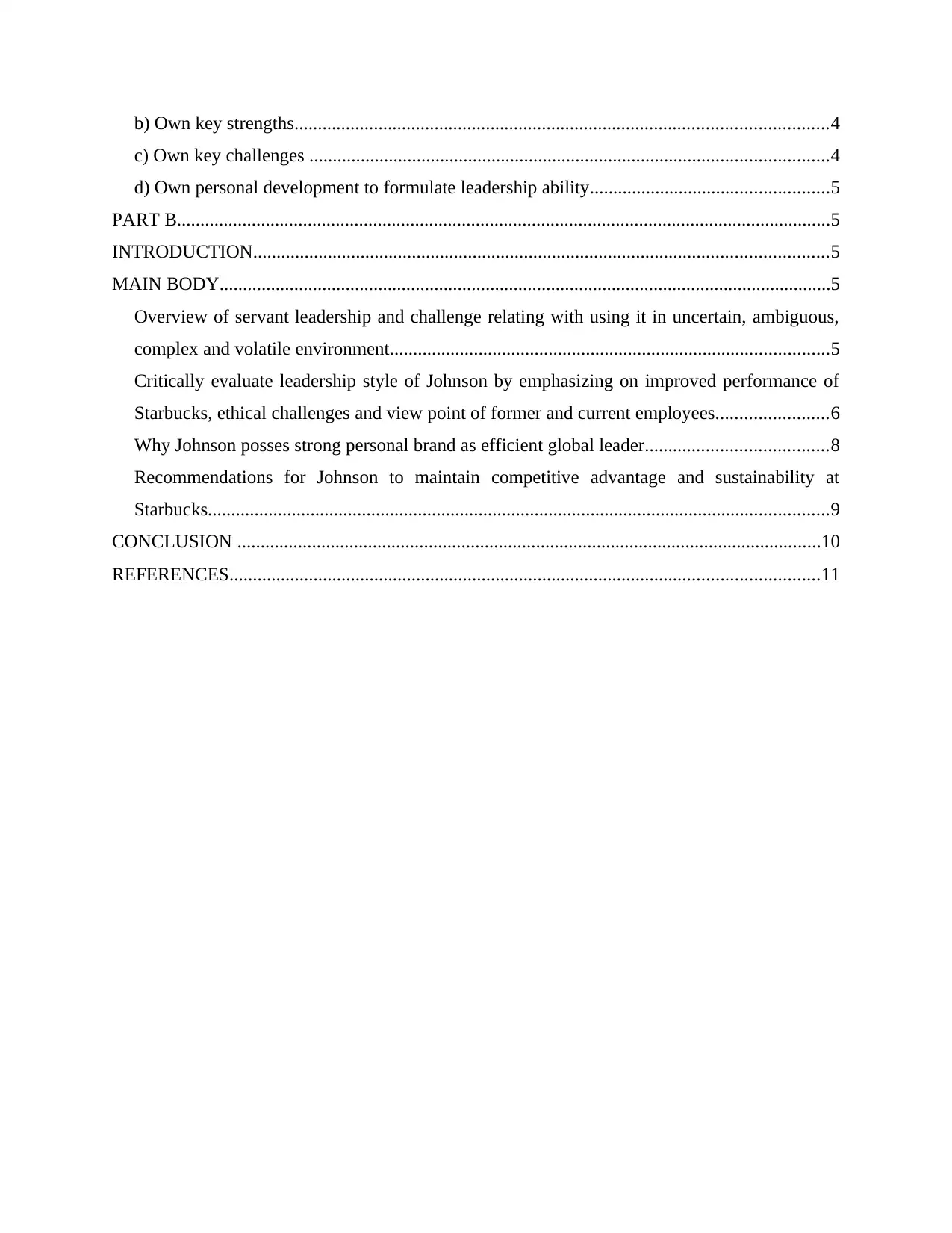
b) Own key strengths..................................................................................................................4
c) Own key challenges ...............................................................................................................4
d) Own personal development to formulate leadership ability...................................................5
PART B............................................................................................................................................5
INTRODUCTION...........................................................................................................................5
MAIN BODY...................................................................................................................................5
Overview of servant leadership and challenge relating with using it in uncertain, ambiguous,
complex and volatile environment..............................................................................................5
Critically evaluate leadership style of Johnson by emphasizing on improved performance of
Starbucks, ethical challenges and view point of former and current employees........................6
Why Johnson posses strong personal brand as efficient global leader.......................................8
Recommendations for Johnson to maintain competitive advantage and sustainability at
Starbucks.....................................................................................................................................9
CONCLUSION .............................................................................................................................10
REFERENCES..............................................................................................................................11
c) Own key challenges ...............................................................................................................4
d) Own personal development to formulate leadership ability...................................................5
PART B............................................................................................................................................5
INTRODUCTION...........................................................................................................................5
MAIN BODY...................................................................................................................................5
Overview of servant leadership and challenge relating with using it in uncertain, ambiguous,
complex and volatile environment..............................................................................................5
Critically evaluate leadership style of Johnson by emphasizing on improved performance of
Starbucks, ethical challenges and view point of former and current employees........................6
Why Johnson posses strong personal brand as efficient global leader.......................................8
Recommendations for Johnson to maintain competitive advantage and sustainability at
Starbucks.....................................................................................................................................9
CONCLUSION .............................................................................................................................10
REFERENCES..............................................................................................................................11
⊘ This is a preview!⊘
Do you want full access?
Subscribe today to unlock all pages.

Trusted by 1+ million students worldwide

Paraphrase This Document
Need a fresh take? Get an instant paraphrase of this document with our AI Paraphraser
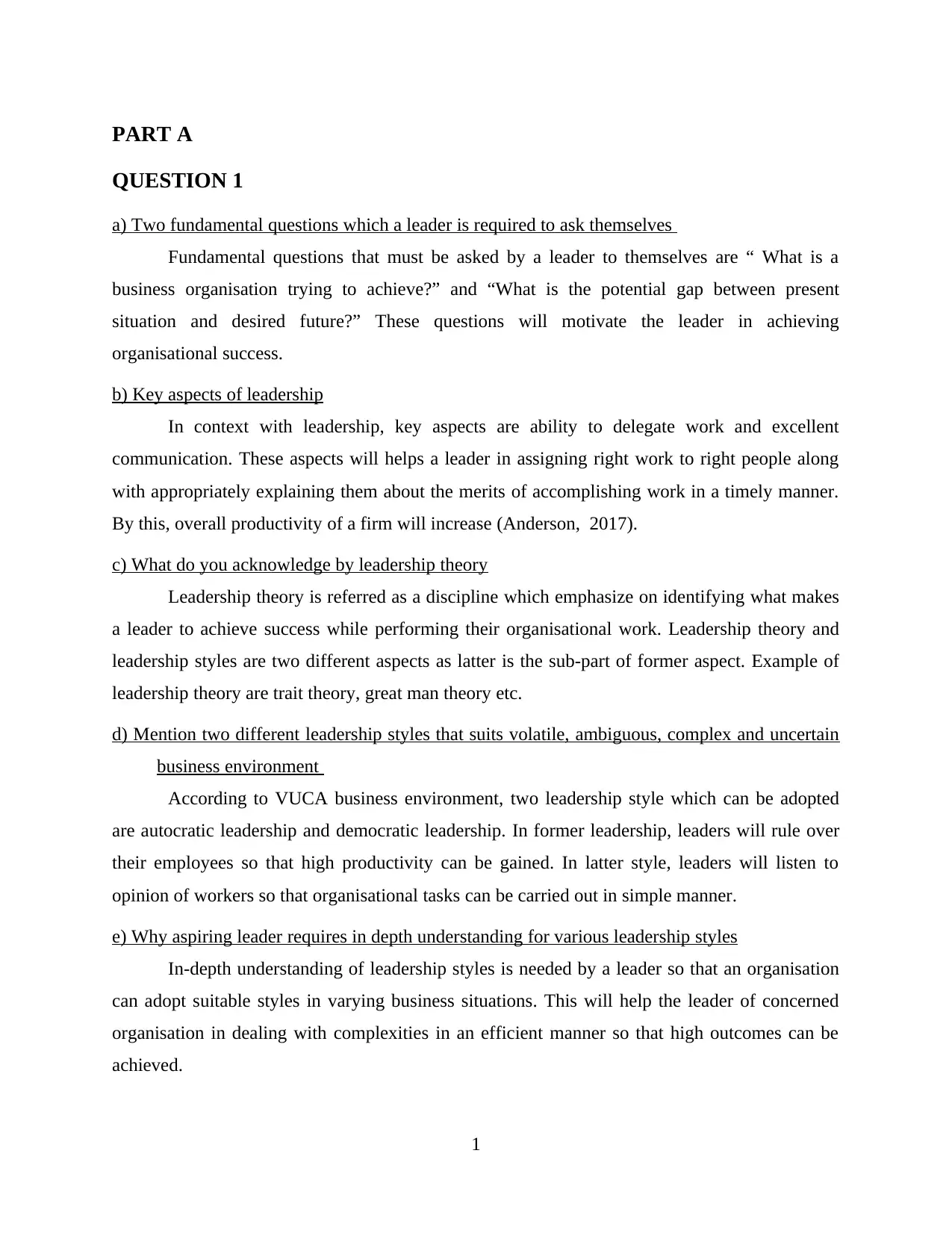
PART A
QUESTION 1
a) Two fundamental questions which a leader is required to ask themselves
Fundamental questions that must be asked by a leader to themselves are “ What is a
business organisation trying to achieve?” and “What is the potential gap between present
situation and desired future?” These questions will motivate the leader in achieving
organisational success.
b) Key aspects of leadership
In context with leadership, key aspects are ability to delegate work and excellent
communication. These aspects will helps a leader in assigning right work to right people along
with appropriately explaining them about the merits of accomplishing work in a timely manner.
By this, overall productivity of a firm will increase (Anderson, 2017).
c) What do you acknowledge by leadership theory
Leadership theory is referred as a discipline which emphasize on identifying what makes
a leader to achieve success while performing their organisational work. Leadership theory and
leadership styles are two different aspects as latter is the sub-part of former aspect. Example of
leadership theory are trait theory, great man theory etc.
d) Mention two different leadership styles that suits volatile, ambiguous, complex and uncertain
business environment
According to VUCA business environment, two leadership style which can be adopted
are autocratic leadership and democratic leadership. In former leadership, leaders will rule over
their employees so that high productivity can be gained. In latter style, leaders will listen to
opinion of workers so that organisational tasks can be carried out in simple manner.
e) Why aspiring leader requires in depth understanding for various leadership styles
In-depth understanding of leadership styles is needed by a leader so that an organisation
can adopt suitable styles in varying business situations. This will help the leader of concerned
organisation in dealing with complexities in an efficient manner so that high outcomes can be
achieved.
1
QUESTION 1
a) Two fundamental questions which a leader is required to ask themselves
Fundamental questions that must be asked by a leader to themselves are “ What is a
business organisation trying to achieve?” and “What is the potential gap between present
situation and desired future?” These questions will motivate the leader in achieving
organisational success.
b) Key aspects of leadership
In context with leadership, key aspects are ability to delegate work and excellent
communication. These aspects will helps a leader in assigning right work to right people along
with appropriately explaining them about the merits of accomplishing work in a timely manner.
By this, overall productivity of a firm will increase (Anderson, 2017).
c) What do you acknowledge by leadership theory
Leadership theory is referred as a discipline which emphasize on identifying what makes
a leader to achieve success while performing their organisational work. Leadership theory and
leadership styles are two different aspects as latter is the sub-part of former aspect. Example of
leadership theory are trait theory, great man theory etc.
d) Mention two different leadership styles that suits volatile, ambiguous, complex and uncertain
business environment
According to VUCA business environment, two leadership style which can be adopted
are autocratic leadership and democratic leadership. In former leadership, leaders will rule over
their employees so that high productivity can be gained. In latter style, leaders will listen to
opinion of workers so that organisational tasks can be carried out in simple manner.
e) Why aspiring leader requires in depth understanding for various leadership styles
In-depth understanding of leadership styles is needed by a leader so that an organisation
can adopt suitable styles in varying business situations. This will help the leader of concerned
organisation in dealing with complexities in an efficient manner so that high outcomes can be
achieved.
1
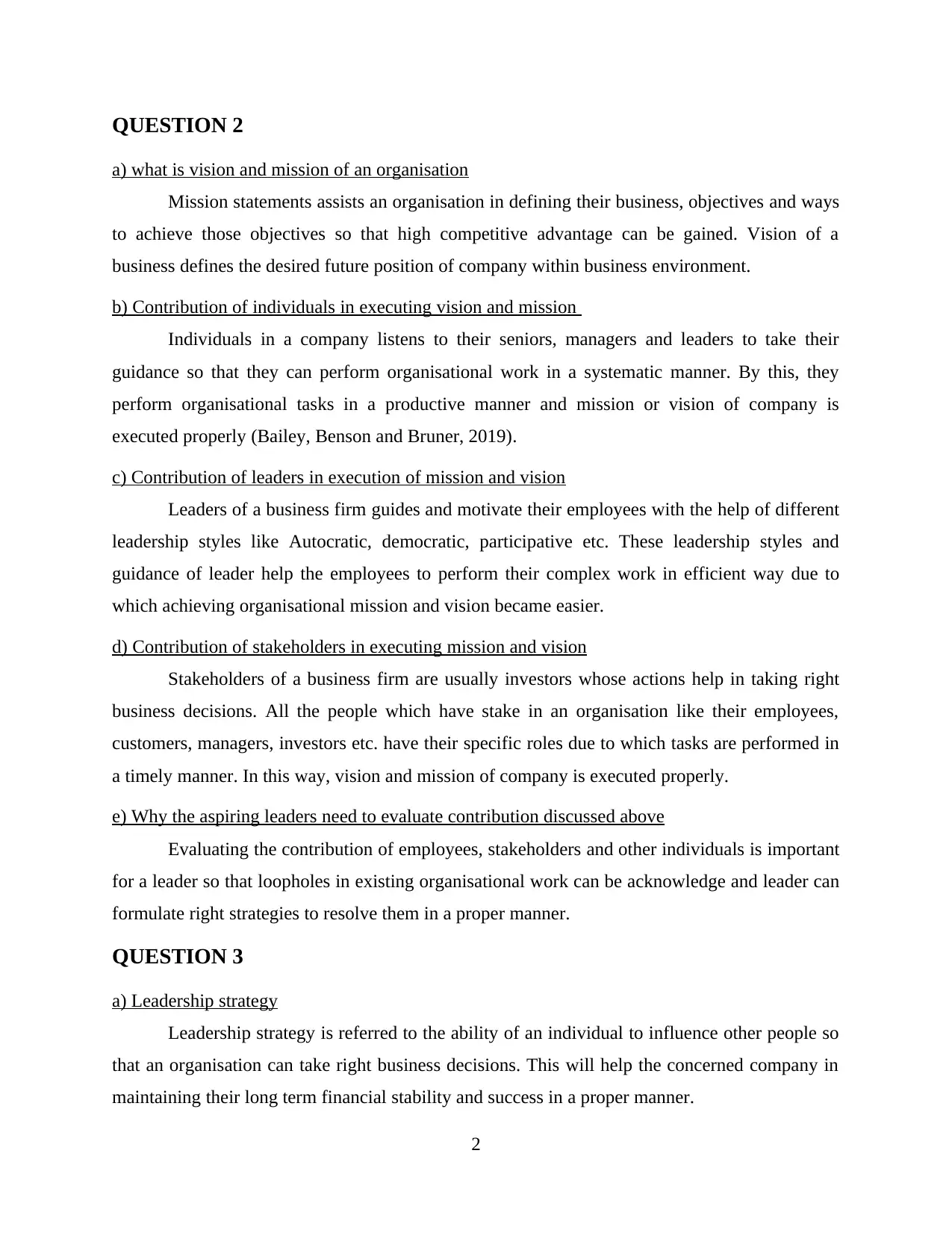
QUESTION 2
a) what is vision and mission of an organisation
Mission statements assists an organisation in defining their business, objectives and ways
to achieve those objectives so that high competitive advantage can be gained. Vision of a
business defines the desired future position of company within business environment.
b) Contribution of individuals in executing vision and mission
Individuals in a company listens to their seniors, managers and leaders to take their
guidance so that they can perform organisational work in a systematic manner. By this, they
perform organisational tasks in a productive manner and mission or vision of company is
executed properly (Bailey, Benson and Bruner, 2019).
c) Contribution of leaders in execution of mission and vision
Leaders of a business firm guides and motivate their employees with the help of different
leadership styles like Autocratic, democratic, participative etc. These leadership styles and
guidance of leader help the employees to perform their complex work in efficient way due to
which achieving organisational mission and vision became easier.
d) Contribution of stakeholders in executing mission and vision
Stakeholders of a business firm are usually investors whose actions help in taking right
business decisions. All the people which have stake in an organisation like their employees,
customers, managers, investors etc. have their specific roles due to which tasks are performed in
a timely manner. In this way, vision and mission of company is executed properly.
e) Why the aspiring leaders need to evaluate contribution discussed above
Evaluating the contribution of employees, stakeholders and other individuals is important
for a leader so that loopholes in existing organisational work can be acknowledge and leader can
formulate right strategies to resolve them in a proper manner.
QUESTION 3
a) Leadership strategy
Leadership strategy is referred to the ability of an individual to influence other people so
that an organisation can take right business decisions. This will help the concerned company in
maintaining their long term financial stability and success in a proper manner.
2
a) what is vision and mission of an organisation
Mission statements assists an organisation in defining their business, objectives and ways
to achieve those objectives so that high competitive advantage can be gained. Vision of a
business defines the desired future position of company within business environment.
b) Contribution of individuals in executing vision and mission
Individuals in a company listens to their seniors, managers and leaders to take their
guidance so that they can perform organisational work in a systematic manner. By this, they
perform organisational tasks in a productive manner and mission or vision of company is
executed properly (Bailey, Benson and Bruner, 2019).
c) Contribution of leaders in execution of mission and vision
Leaders of a business firm guides and motivate their employees with the help of different
leadership styles like Autocratic, democratic, participative etc. These leadership styles and
guidance of leader help the employees to perform their complex work in efficient way due to
which achieving organisational mission and vision became easier.
d) Contribution of stakeholders in executing mission and vision
Stakeholders of a business firm are usually investors whose actions help in taking right
business decisions. All the people which have stake in an organisation like their employees,
customers, managers, investors etc. have their specific roles due to which tasks are performed in
a timely manner. In this way, vision and mission of company is executed properly.
e) Why the aspiring leaders need to evaluate contribution discussed above
Evaluating the contribution of employees, stakeholders and other individuals is important
for a leader so that loopholes in existing organisational work can be acknowledge and leader can
formulate right strategies to resolve them in a proper manner.
QUESTION 3
a) Leadership strategy
Leadership strategy is referred to the ability of an individual to influence other people so
that an organisation can take right business decisions. This will help the concerned company in
maintaining their long term financial stability and success in a proper manner.
2
⊘ This is a preview!⊘
Do you want full access?
Subscribe today to unlock all pages.

Trusted by 1+ million students worldwide
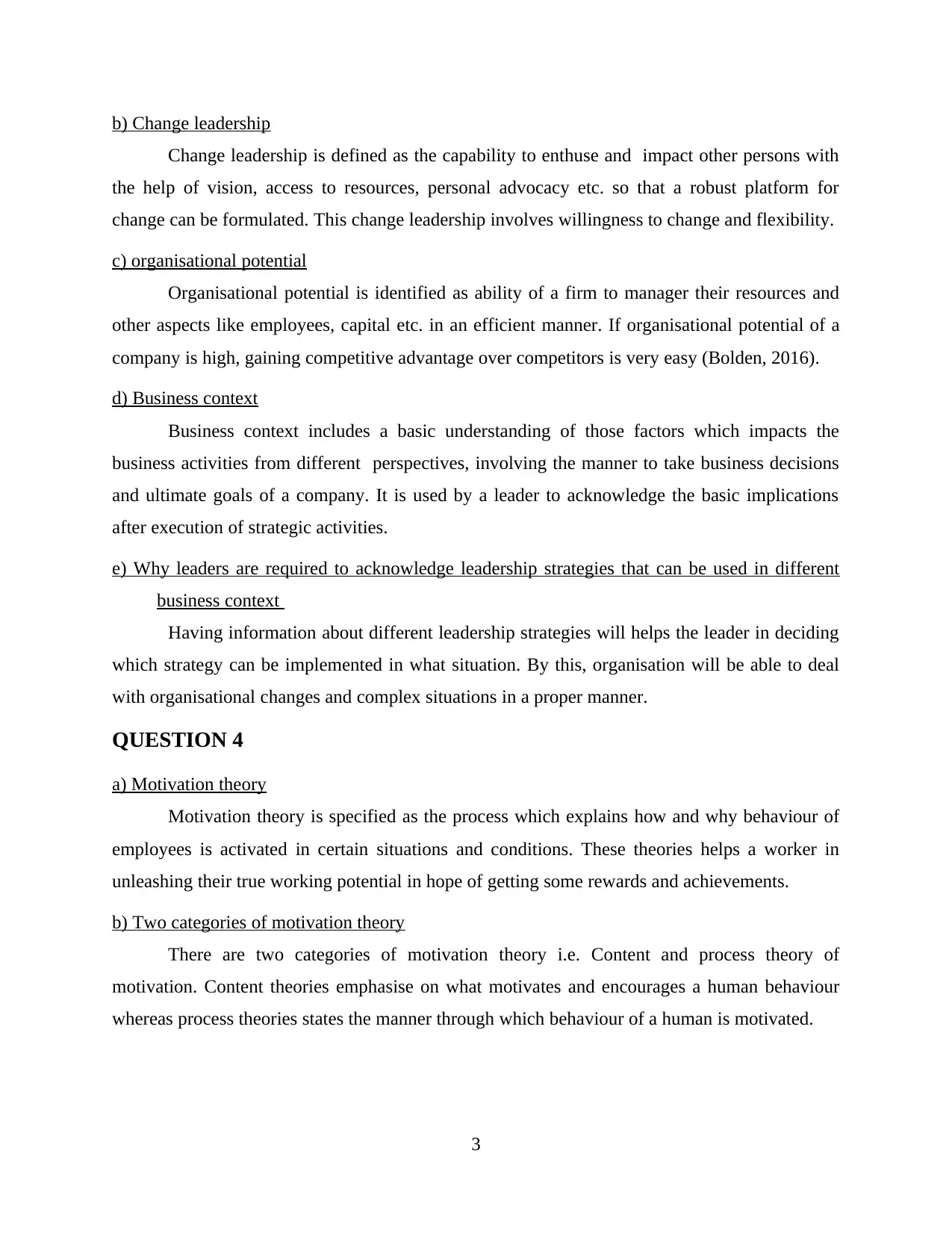
b) Change leadership
Change leadership is defined as the capability to enthuse and impact other persons with
the help of vision, access to resources, personal advocacy etc. so that a robust platform for
change can be formulated. This change leadership involves willingness to change and flexibility.
c) organisational potential
Organisational potential is identified as ability of a firm to manager their resources and
other aspects like employees, capital etc. in an efficient manner. If organisational potential of a
company is high, gaining competitive advantage over competitors is very easy (Bolden, 2016).
d) Business context
Business context includes a basic understanding of those factors which impacts the
business activities from different perspectives, involving the manner to take business decisions
and ultimate goals of a company. It is used by a leader to acknowledge the basic implications
after execution of strategic activities.
e) Why leaders are required to acknowledge leadership strategies that can be used in different
business context
Having information about different leadership strategies will helps the leader in deciding
which strategy can be implemented in what situation. By this, organisation will be able to deal
with organisational changes and complex situations in a proper manner.
QUESTION 4
a) Motivation theory
Motivation theory is specified as the process which explains how and why behaviour of
employees is activated in certain situations and conditions. These theories helps a worker in
unleashing their true working potential in hope of getting some rewards and achievements.
b) Two categories of motivation theory
There are two categories of motivation theory i.e. Content and process theory of
motivation. Content theories emphasise on what motivates and encourages a human behaviour
whereas process theories states the manner through which behaviour of a human is motivated.
3
Change leadership is defined as the capability to enthuse and impact other persons with
the help of vision, access to resources, personal advocacy etc. so that a robust platform for
change can be formulated. This change leadership involves willingness to change and flexibility.
c) organisational potential
Organisational potential is identified as ability of a firm to manager their resources and
other aspects like employees, capital etc. in an efficient manner. If organisational potential of a
company is high, gaining competitive advantage over competitors is very easy (Bolden, 2016).
d) Business context
Business context includes a basic understanding of those factors which impacts the
business activities from different perspectives, involving the manner to take business decisions
and ultimate goals of a company. It is used by a leader to acknowledge the basic implications
after execution of strategic activities.
e) Why leaders are required to acknowledge leadership strategies that can be used in different
business context
Having information about different leadership strategies will helps the leader in deciding
which strategy can be implemented in what situation. By this, organisation will be able to deal
with organisational changes and complex situations in a proper manner.
QUESTION 4
a) Motivation theory
Motivation theory is specified as the process which explains how and why behaviour of
employees is activated in certain situations and conditions. These theories helps a worker in
unleashing their true working potential in hope of getting some rewards and achievements.
b) Two categories of motivation theory
There are two categories of motivation theory i.e. Content and process theory of
motivation. Content theories emphasise on what motivates and encourages a human behaviour
whereas process theories states the manner through which behaviour of a human is motivated.
3
Paraphrase This Document
Need a fresh take? Get an instant paraphrase of this document with our AI Paraphraser
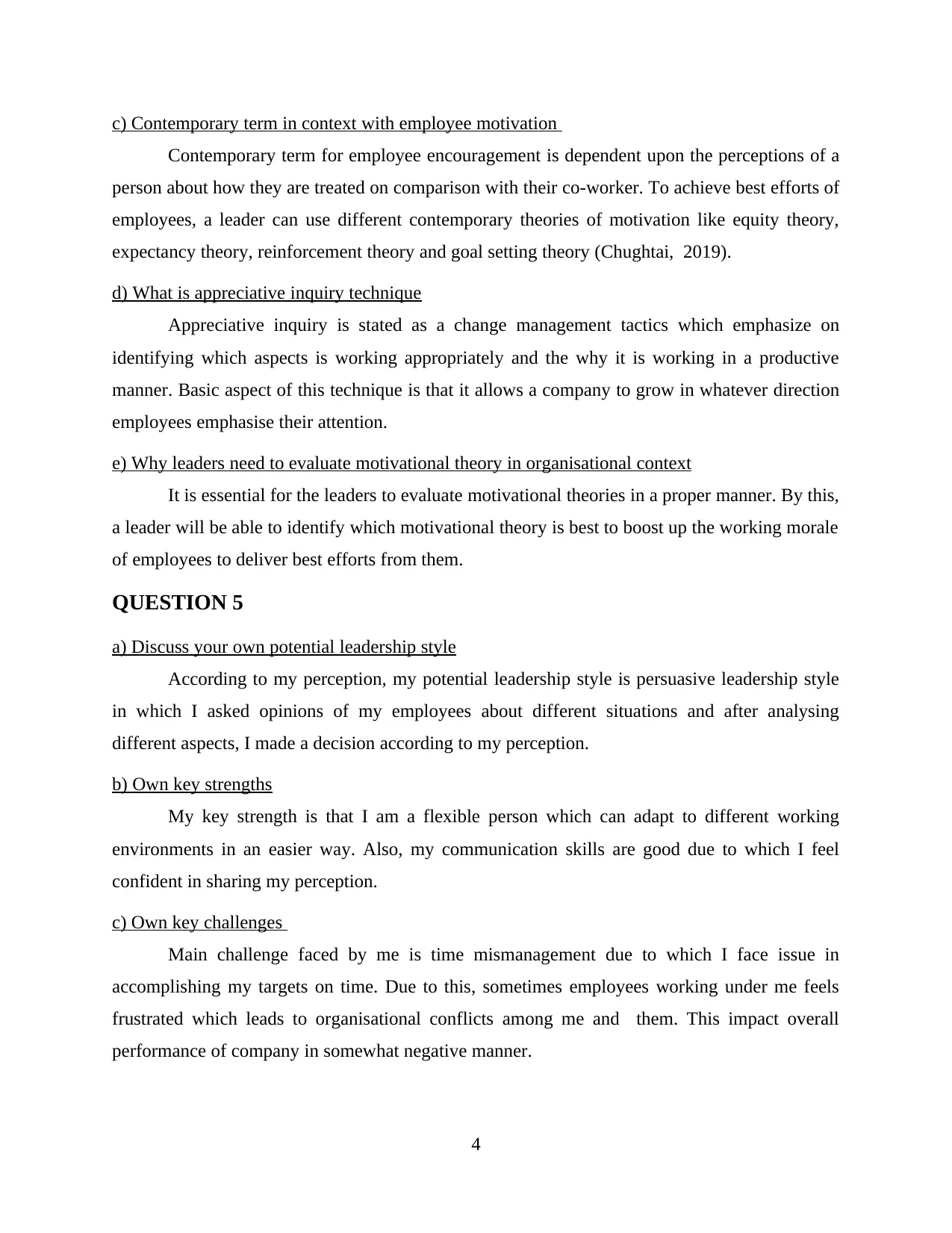
c) Contemporary term in context with employee motivation
Contemporary term for employee encouragement is dependent upon the perceptions of a
person about how they are treated on comparison with their co-worker. To achieve best efforts of
employees, a leader can use different contemporary theories of motivation like equity theory,
expectancy theory, reinforcement theory and goal setting theory (Chughtai, 2019).
d) What is appreciative inquiry technique
Appreciative inquiry is stated as a change management tactics which emphasize on
identifying which aspects is working appropriately and the why it is working in a productive
manner. Basic aspect of this technique is that it allows a company to grow in whatever direction
employees emphasise their attention.
e) Why leaders need to evaluate motivational theory in organisational context
It is essential for the leaders to evaluate motivational theories in a proper manner. By this,
a leader will be able to identify which motivational theory is best to boost up the working morale
of employees to deliver best efforts from them.
QUESTION 5
a) Discuss your own potential leadership style
According to my perception, my potential leadership style is persuasive leadership style
in which I asked opinions of my employees about different situations and after analysing
different aspects, I made a decision according to my perception.
b) Own key strengths
My key strength is that I am a flexible person which can adapt to different working
environments in an easier way. Also, my communication skills are good due to which I feel
confident in sharing my perception.
c) Own key challenges
Main challenge faced by me is time mismanagement due to which I face issue in
accomplishing my targets on time. Due to this, sometimes employees working under me feels
frustrated which leads to organisational conflicts among me and them. This impact overall
performance of company in somewhat negative manner.
4
Contemporary term for employee encouragement is dependent upon the perceptions of a
person about how they are treated on comparison with their co-worker. To achieve best efforts of
employees, a leader can use different contemporary theories of motivation like equity theory,
expectancy theory, reinforcement theory and goal setting theory (Chughtai, 2019).
d) What is appreciative inquiry technique
Appreciative inquiry is stated as a change management tactics which emphasize on
identifying which aspects is working appropriately and the why it is working in a productive
manner. Basic aspect of this technique is that it allows a company to grow in whatever direction
employees emphasise their attention.
e) Why leaders need to evaluate motivational theory in organisational context
It is essential for the leaders to evaluate motivational theories in a proper manner. By this,
a leader will be able to identify which motivational theory is best to boost up the working morale
of employees to deliver best efforts from them.
QUESTION 5
a) Discuss your own potential leadership style
According to my perception, my potential leadership style is persuasive leadership style
in which I asked opinions of my employees about different situations and after analysing
different aspects, I made a decision according to my perception.
b) Own key strengths
My key strength is that I am a flexible person which can adapt to different working
environments in an easier way. Also, my communication skills are good due to which I feel
confident in sharing my perception.
c) Own key challenges
Main challenge faced by me is time mismanagement due to which I face issue in
accomplishing my targets on time. Due to this, sometimes employees working under me feels
frustrated which leads to organisational conflicts among me and them. This impact overall
performance of company in somewhat negative manner.
4
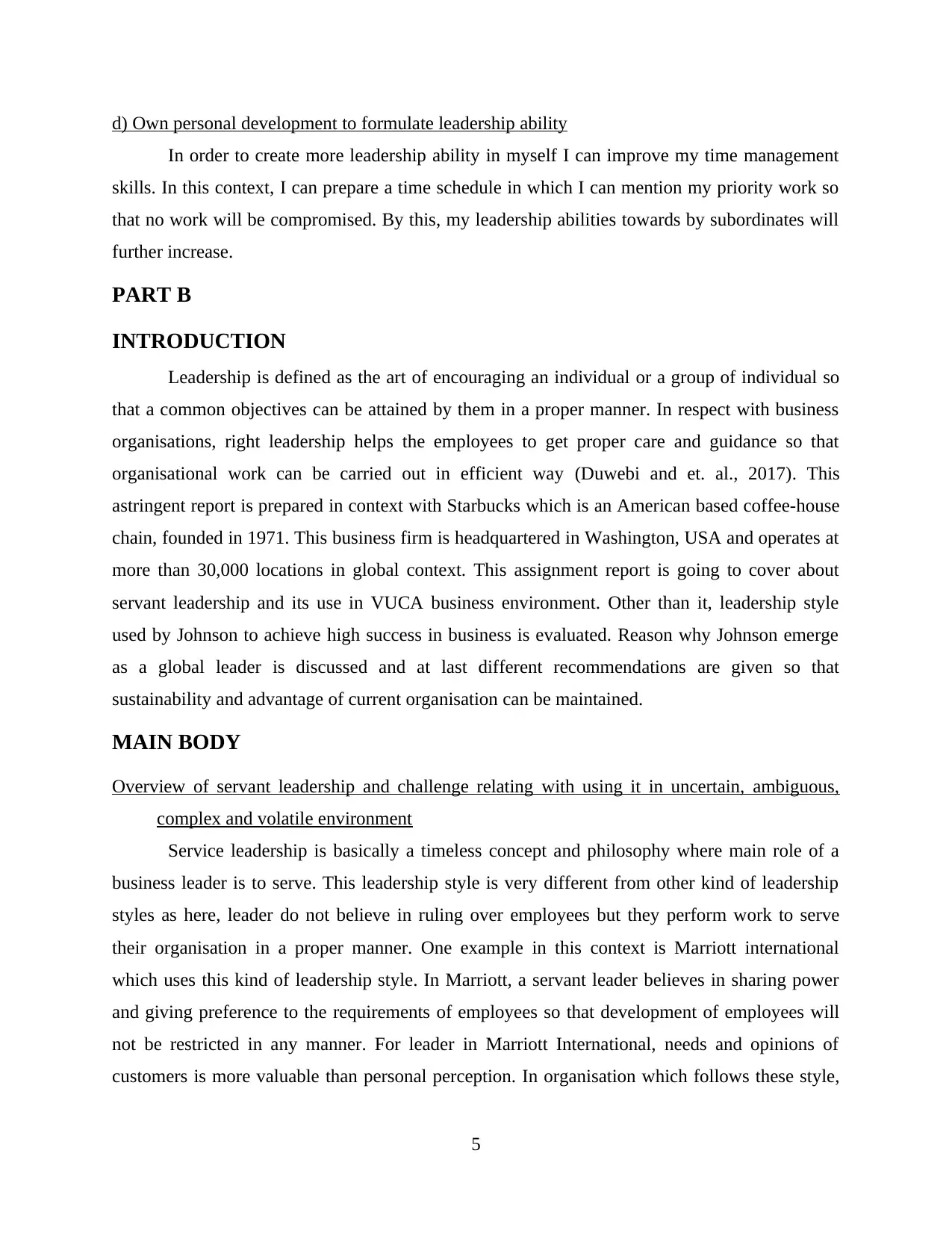
d) Own personal development to formulate leadership ability
In order to create more leadership ability in myself I can improve my time management
skills. In this context, I can prepare a time schedule in which I can mention my priority work so
that no work will be compromised. By this, my leadership abilities towards by subordinates will
further increase.
PART B
INTRODUCTION
Leadership is defined as the art of encouraging an individual or a group of individual so
that a common objectives can be attained by them in a proper manner. In respect with business
organisations, right leadership helps the employees to get proper care and guidance so that
organisational work can be carried out in efficient way (Duwebi and et. al., 2017). This
astringent report is prepared in context with Starbucks which is an American based coffee-house
chain, founded in 1971. This business firm is headquartered in Washington, USA and operates at
more than 30,000 locations in global context. This assignment report is going to cover about
servant leadership and its use in VUCA business environment. Other than it, leadership style
used by Johnson to achieve high success in business is evaluated. Reason why Johnson emerge
as a global leader is discussed and at last different recommendations are given so that
sustainability and advantage of current organisation can be maintained.
MAIN BODY
Overview of servant leadership and challenge relating with using it in uncertain, ambiguous,
complex and volatile environment
Service leadership is basically a timeless concept and philosophy where main role of a
business leader is to serve. This leadership style is very different from other kind of leadership
styles as here, leader do not believe in ruling over employees but they perform work to serve
their organisation in a proper manner. One example in this context is Marriott international
which uses this kind of leadership style. In Marriott, a servant leader believes in sharing power
and giving preference to the requirements of employees so that development of employees will
not be restricted in any manner. For leader in Marriott International, needs and opinions of
customers is more valuable than personal perception. In organisation which follows these style,
5
In order to create more leadership ability in myself I can improve my time management
skills. In this context, I can prepare a time schedule in which I can mention my priority work so
that no work will be compromised. By this, my leadership abilities towards by subordinates will
further increase.
PART B
INTRODUCTION
Leadership is defined as the art of encouraging an individual or a group of individual so
that a common objectives can be attained by them in a proper manner. In respect with business
organisations, right leadership helps the employees to get proper care and guidance so that
organisational work can be carried out in efficient way (Duwebi and et. al., 2017). This
astringent report is prepared in context with Starbucks which is an American based coffee-house
chain, founded in 1971. This business firm is headquartered in Washington, USA and operates at
more than 30,000 locations in global context. This assignment report is going to cover about
servant leadership and its use in VUCA business environment. Other than it, leadership style
used by Johnson to achieve high success in business is evaluated. Reason why Johnson emerge
as a global leader is discussed and at last different recommendations are given so that
sustainability and advantage of current organisation can be maintained.
MAIN BODY
Overview of servant leadership and challenge relating with using it in uncertain, ambiguous,
complex and volatile environment
Service leadership is basically a timeless concept and philosophy where main role of a
business leader is to serve. This leadership style is very different from other kind of leadership
styles as here, leader do not believe in ruling over employees but they perform work to serve
their organisation in a proper manner. One example in this context is Marriott international
which uses this kind of leadership style. In Marriott, a servant leader believes in sharing power
and giving preference to the requirements of employees so that development of employees will
not be restricted in any manner. For leader in Marriott International, needs and opinions of
customers is more valuable than personal perception. In organisation which follows these style,
5
⊘ This is a preview!⊘
Do you want full access?
Subscribe today to unlock all pages.

Trusted by 1+ million students worldwide
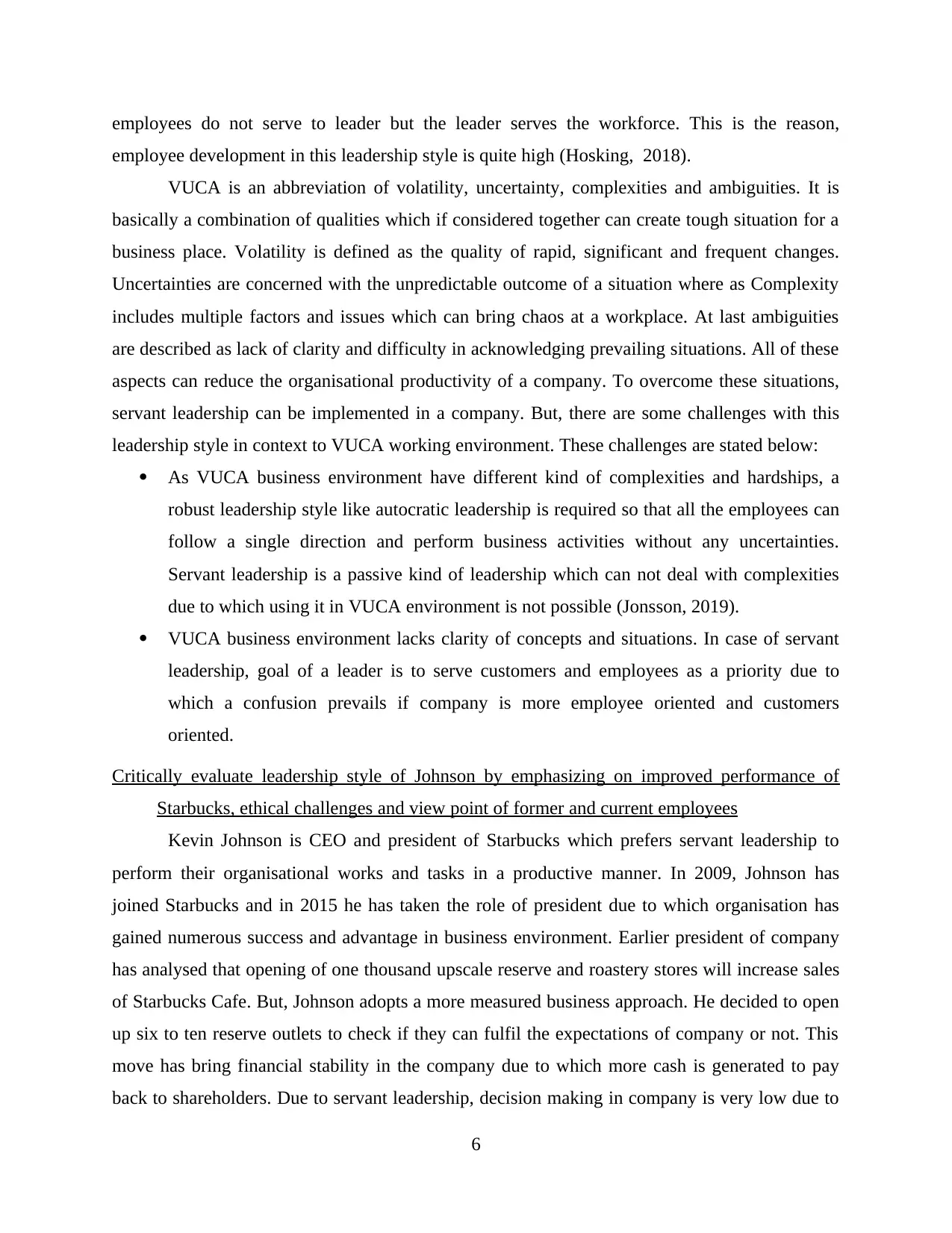
employees do not serve to leader but the leader serves the workforce. This is the reason,
employee development in this leadership style is quite high (Hosking, 2018).
VUCA is an abbreviation of volatility, uncertainty, complexities and ambiguities. It is
basically a combination of qualities which if considered together can create tough situation for a
business place. Volatility is defined as the quality of rapid, significant and frequent changes.
Uncertainties are concerned with the unpredictable outcome of a situation where as Complexity
includes multiple factors and issues which can bring chaos at a workplace. At last ambiguities
are described as lack of clarity and difficulty in acknowledging prevailing situations. All of these
aspects can reduce the organisational productivity of a company. To overcome these situations,
servant leadership can be implemented in a company. But, there are some challenges with this
leadership style in context to VUCA working environment. These challenges are stated below:
As VUCA business environment have different kind of complexities and hardships, a
robust leadership style like autocratic leadership is required so that all the employees can
follow a single direction and perform business activities without any uncertainties.
Servant leadership is a passive kind of leadership which can not deal with complexities
due to which using it in VUCA environment is not possible (Jonsson, 2019).
VUCA business environment lacks clarity of concepts and situations. In case of servant
leadership, goal of a leader is to serve customers and employees as a priority due to
which a confusion prevails if company is more employee oriented and customers
oriented.
Critically evaluate leadership style of Johnson by emphasizing on improved performance of
Starbucks, ethical challenges and view point of former and current employees
Kevin Johnson is CEO and president of Starbucks which prefers servant leadership to
perform their organisational works and tasks in a productive manner. In 2009, Johnson has
joined Starbucks and in 2015 he has taken the role of president due to which organisation has
gained numerous success and advantage in business environment. Earlier president of company
has analysed that opening of one thousand upscale reserve and roastery stores will increase sales
of Starbucks Cafe. But, Johnson adopts a more measured business approach. He decided to open
up six to ten reserve outlets to check if they can fulfil the expectations of company or not. This
move has bring financial stability in the company due to which more cash is generated to pay
back to shareholders. Due to servant leadership, decision making in company is very low due to
6
employee development in this leadership style is quite high (Hosking, 2018).
VUCA is an abbreviation of volatility, uncertainty, complexities and ambiguities. It is
basically a combination of qualities which if considered together can create tough situation for a
business place. Volatility is defined as the quality of rapid, significant and frequent changes.
Uncertainties are concerned with the unpredictable outcome of a situation where as Complexity
includes multiple factors and issues which can bring chaos at a workplace. At last ambiguities
are described as lack of clarity and difficulty in acknowledging prevailing situations. All of these
aspects can reduce the organisational productivity of a company. To overcome these situations,
servant leadership can be implemented in a company. But, there are some challenges with this
leadership style in context to VUCA working environment. These challenges are stated below:
As VUCA business environment have different kind of complexities and hardships, a
robust leadership style like autocratic leadership is required so that all the employees can
follow a single direction and perform business activities without any uncertainties.
Servant leadership is a passive kind of leadership which can not deal with complexities
due to which using it in VUCA environment is not possible (Jonsson, 2019).
VUCA business environment lacks clarity of concepts and situations. In case of servant
leadership, goal of a leader is to serve customers and employees as a priority due to
which a confusion prevails if company is more employee oriented and customers
oriented.
Critically evaluate leadership style of Johnson by emphasizing on improved performance of
Starbucks, ethical challenges and view point of former and current employees
Kevin Johnson is CEO and president of Starbucks which prefers servant leadership to
perform their organisational works and tasks in a productive manner. In 2009, Johnson has
joined Starbucks and in 2015 he has taken the role of president due to which organisation has
gained numerous success and advantage in business environment. Earlier president of company
has analysed that opening of one thousand upscale reserve and roastery stores will increase sales
of Starbucks Cafe. But, Johnson adopts a more measured business approach. He decided to open
up six to ten reserve outlets to check if they can fulfil the expectations of company or not. This
move has bring financial stability in the company due to which more cash is generated to pay
back to shareholders. Due to servant leadership, decision making in company is very low due to
6
Paraphrase This Document
Need a fresh take? Get an instant paraphrase of this document with our AI Paraphraser
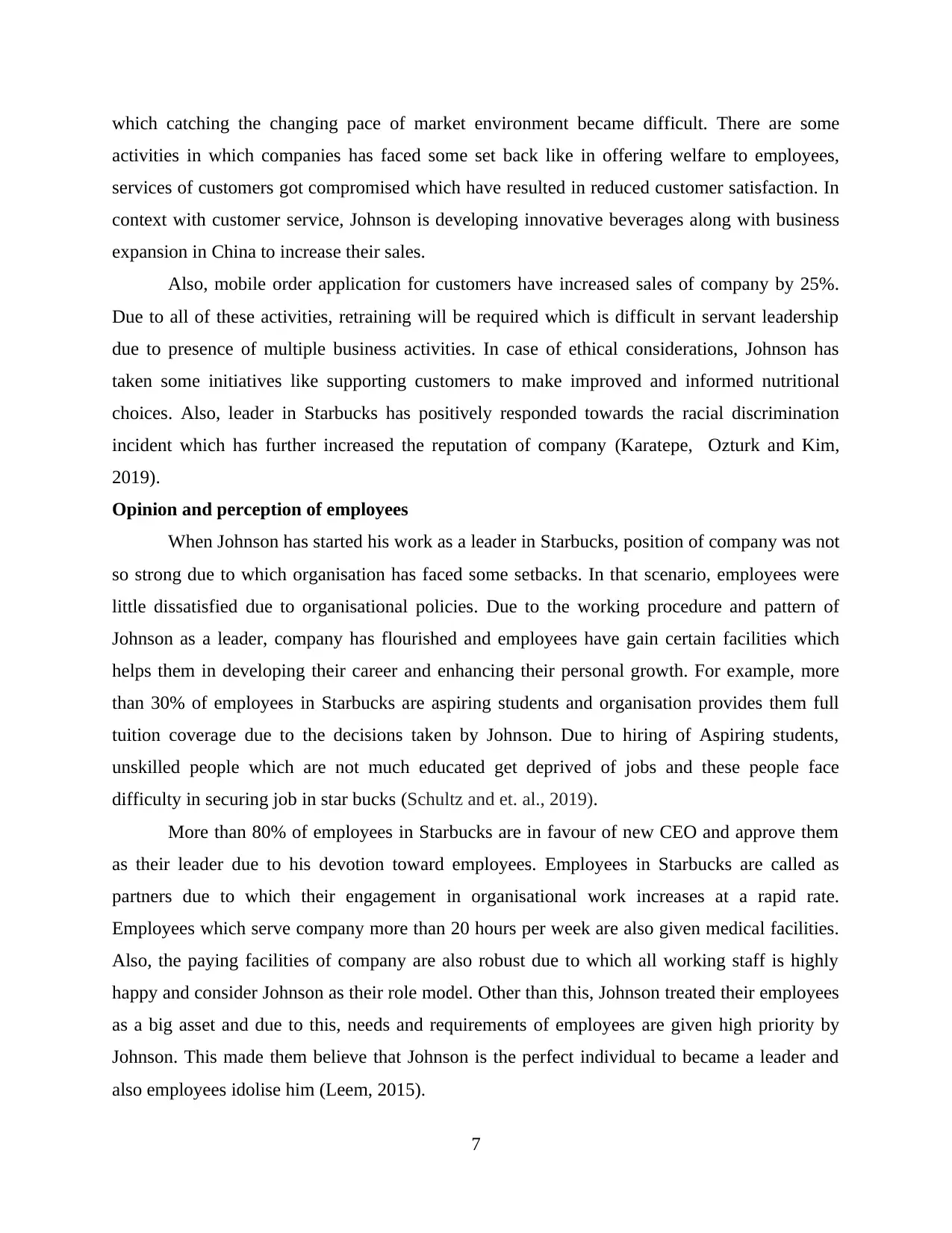
which catching the changing pace of market environment became difficult. There are some
activities in which companies has faced some set back like in offering welfare to employees,
services of customers got compromised which have resulted in reduced customer satisfaction. In
context with customer service, Johnson is developing innovative beverages along with business
expansion in China to increase their sales.
Also, mobile order application for customers have increased sales of company by 25%.
Due to all of these activities, retraining will be required which is difficult in servant leadership
due to presence of multiple business activities. In case of ethical considerations, Johnson has
taken some initiatives like supporting customers to make improved and informed nutritional
choices. Also, leader in Starbucks has positively responded towards the racial discrimination
incident which has further increased the reputation of company (Karatepe, Ozturk and Kim,
2019).
Opinion and perception of employees
When Johnson has started his work as a leader in Starbucks, position of company was not
so strong due to which organisation has faced some setbacks. In that scenario, employees were
little dissatisfied due to organisational policies. Due to the working procedure and pattern of
Johnson as a leader, company has flourished and employees have gain certain facilities which
helps them in developing their career and enhancing their personal growth. For example, more
than 30% of employees in Starbucks are aspiring students and organisation provides them full
tuition coverage due to the decisions taken by Johnson. Due to hiring of Aspiring students,
unskilled people which are not much educated get deprived of jobs and these people face
difficulty in securing job in star bucks (Schultz and et. al., 2019).
More than 80% of employees in Starbucks are in favour of new CEO and approve them
as their leader due to his devotion toward employees. Employees in Starbucks are called as
partners due to which their engagement in organisational work increases at a rapid rate.
Employees which serve company more than 20 hours per week are also given medical facilities.
Also, the paying facilities of company are also robust due to which all working staff is highly
happy and consider Johnson as their role model. Other than this, Johnson treated their employees
as a big asset and due to this, needs and requirements of employees are given high priority by
Johnson. This made them believe that Johnson is the perfect individual to became a leader and
also employees idolise him (Leem, 2015).
7
activities in which companies has faced some set back like in offering welfare to employees,
services of customers got compromised which have resulted in reduced customer satisfaction. In
context with customer service, Johnson is developing innovative beverages along with business
expansion in China to increase their sales.
Also, mobile order application for customers have increased sales of company by 25%.
Due to all of these activities, retraining will be required which is difficult in servant leadership
due to presence of multiple business activities. In case of ethical considerations, Johnson has
taken some initiatives like supporting customers to make improved and informed nutritional
choices. Also, leader in Starbucks has positively responded towards the racial discrimination
incident which has further increased the reputation of company (Karatepe, Ozturk and Kim,
2019).
Opinion and perception of employees
When Johnson has started his work as a leader in Starbucks, position of company was not
so strong due to which organisation has faced some setbacks. In that scenario, employees were
little dissatisfied due to organisational policies. Due to the working procedure and pattern of
Johnson as a leader, company has flourished and employees have gain certain facilities which
helps them in developing their career and enhancing their personal growth. For example, more
than 30% of employees in Starbucks are aspiring students and organisation provides them full
tuition coverage due to the decisions taken by Johnson. Due to hiring of Aspiring students,
unskilled people which are not much educated get deprived of jobs and these people face
difficulty in securing job in star bucks (Schultz and et. al., 2019).
More than 80% of employees in Starbucks are in favour of new CEO and approve them
as their leader due to his devotion toward employees. Employees in Starbucks are called as
partners due to which their engagement in organisational work increases at a rapid rate.
Employees which serve company more than 20 hours per week are also given medical facilities.
Also, the paying facilities of company are also robust due to which all working staff is highly
happy and consider Johnson as their role model. Other than this, Johnson treated their employees
as a big asset and due to this, needs and requirements of employees are given high priority by
Johnson. This made them believe that Johnson is the perfect individual to became a leader and
also employees idolise him (Leem, 2015).
7
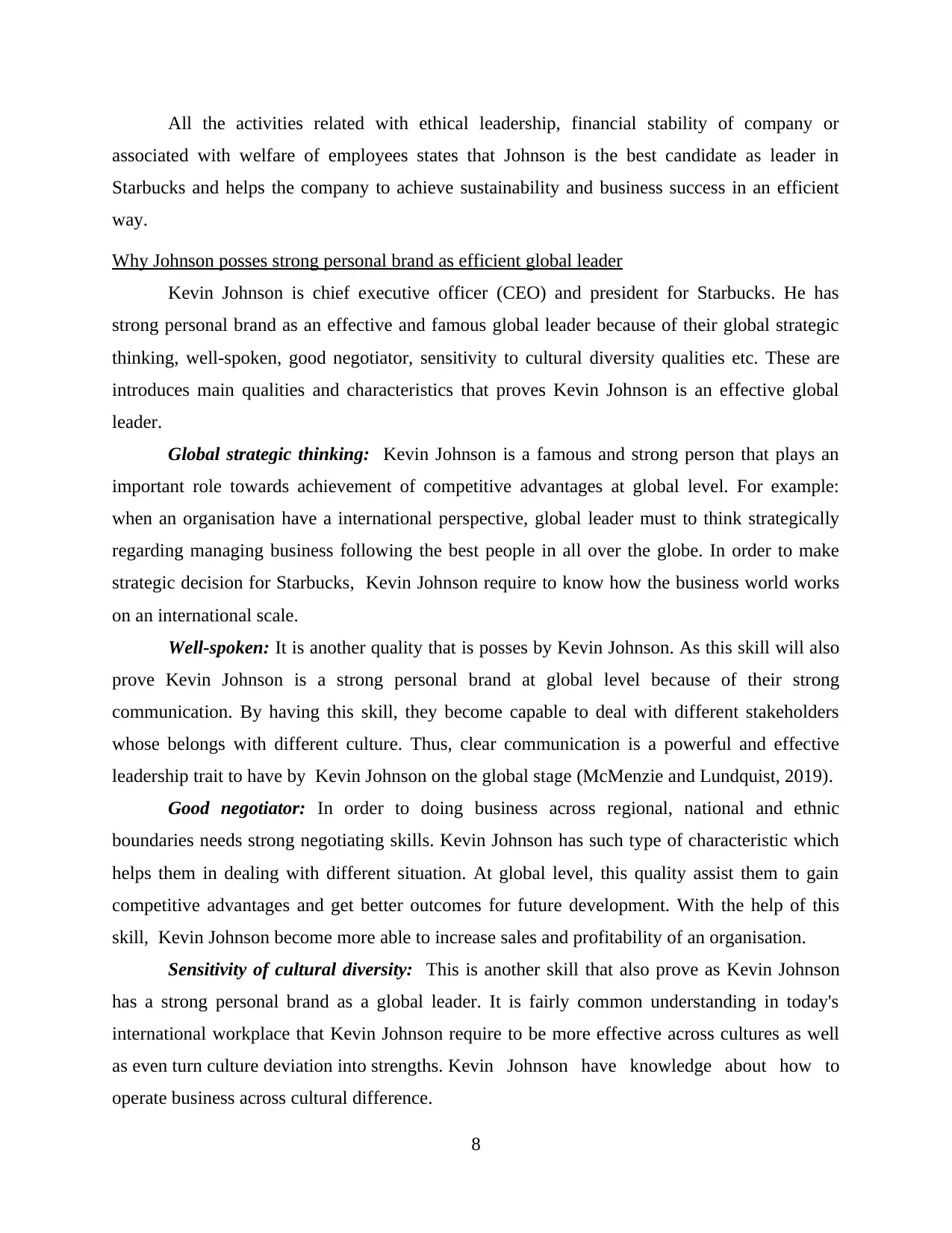
All the activities related with ethical leadership, financial stability of company or
associated with welfare of employees states that Johnson is the best candidate as leader in
Starbucks and helps the company to achieve sustainability and business success in an efficient
way.
Why Johnson posses strong personal brand as efficient global leader
Kevin Johnson is chief executive officer (CEO) and president for Starbucks. He has
strong personal brand as an effective and famous global leader because of their global strategic
thinking, well-spoken, good negotiator, sensitivity to cultural diversity qualities etc. These are
introduces main qualities and characteristics that proves Kevin Johnson is an effective global
leader.
Global strategic thinking: Kevin Johnson is a famous and strong person that plays an
important role towards achievement of competitive advantages at global level. For example:
when an organisation have a international perspective, global leader must to think strategically
regarding managing business following the best people in all over the globe. In order to make
strategic decision for Starbucks, Kevin Johnson require to know how the business world works
on an international scale.
Well-spoken: It is another quality that is posses by Kevin Johnson. As this skill will also
prove Kevin Johnson is a strong personal brand at global level because of their strong
communication. By having this skill, they become capable to deal with different stakeholders
whose belongs with different culture. Thus, clear communication is a powerful and effective
leadership trait to have by Kevin Johnson on the global stage (McMenzie and Lundquist, 2019).
Good negotiator: In order to doing business across regional, national and ethnic
boundaries needs strong negotiating skills. Kevin Johnson has such type of characteristic which
helps them in dealing with different situation. At global level, this quality assist them to gain
competitive advantages and get better outcomes for future development. With the help of this
skill, Kevin Johnson become more able to increase sales and profitability of an organisation.
Sensitivity of cultural diversity: This is another skill that also prove as Kevin Johnson
has a strong personal brand as a global leader. It is fairly common understanding in today's
international workplace that Kevin Johnson require to be more effective across cultures as well
as even turn culture deviation into strengths. Kevin Johnson have knowledge about how to
operate business across cultural difference.
8
associated with welfare of employees states that Johnson is the best candidate as leader in
Starbucks and helps the company to achieve sustainability and business success in an efficient
way.
Why Johnson posses strong personal brand as efficient global leader
Kevin Johnson is chief executive officer (CEO) and president for Starbucks. He has
strong personal brand as an effective and famous global leader because of their global strategic
thinking, well-spoken, good negotiator, sensitivity to cultural diversity qualities etc. These are
introduces main qualities and characteristics that proves Kevin Johnson is an effective global
leader.
Global strategic thinking: Kevin Johnson is a famous and strong person that plays an
important role towards achievement of competitive advantages at global level. For example:
when an organisation have a international perspective, global leader must to think strategically
regarding managing business following the best people in all over the globe. In order to make
strategic decision for Starbucks, Kevin Johnson require to know how the business world works
on an international scale.
Well-spoken: It is another quality that is posses by Kevin Johnson. As this skill will also
prove Kevin Johnson is a strong personal brand at global level because of their strong
communication. By having this skill, they become capable to deal with different stakeholders
whose belongs with different culture. Thus, clear communication is a powerful and effective
leadership trait to have by Kevin Johnson on the global stage (McMenzie and Lundquist, 2019).
Good negotiator: In order to doing business across regional, national and ethnic
boundaries needs strong negotiating skills. Kevin Johnson has such type of characteristic which
helps them in dealing with different situation. At global level, this quality assist them to gain
competitive advantages and get better outcomes for future development. With the help of this
skill, Kevin Johnson become more able to increase sales and profitability of an organisation.
Sensitivity of cultural diversity: This is another skill that also prove as Kevin Johnson
has a strong personal brand as a global leader. It is fairly common understanding in today's
international workplace that Kevin Johnson require to be more effective across cultures as well
as even turn culture deviation into strengths. Kevin Johnson have knowledge about how to
operate business across cultural difference.
8
⊘ This is a preview!⊘
Do you want full access?
Subscribe today to unlock all pages.

Trusted by 1+ million students worldwide
1 out of 15
Related Documents
Your All-in-One AI-Powered Toolkit for Academic Success.
+13062052269
info@desklib.com
Available 24*7 on WhatsApp / Email
![[object Object]](/_next/static/media/star-bottom.7253800d.svg)
Unlock your academic potential
Copyright © 2020–2025 A2Z Services. All Rights Reserved. Developed and managed by ZUCOL.





